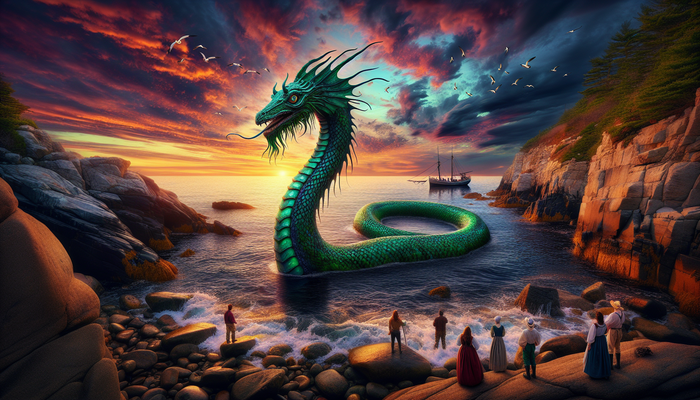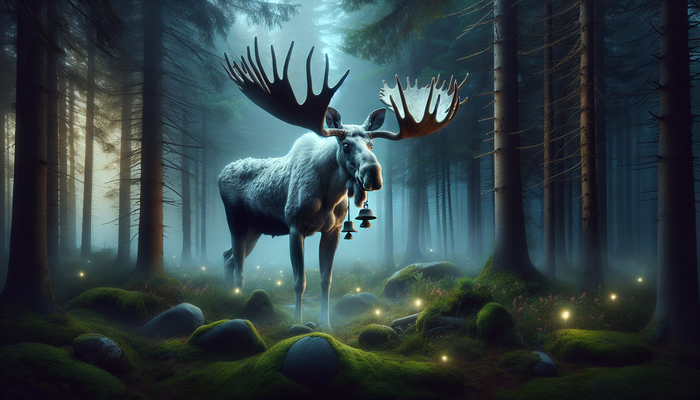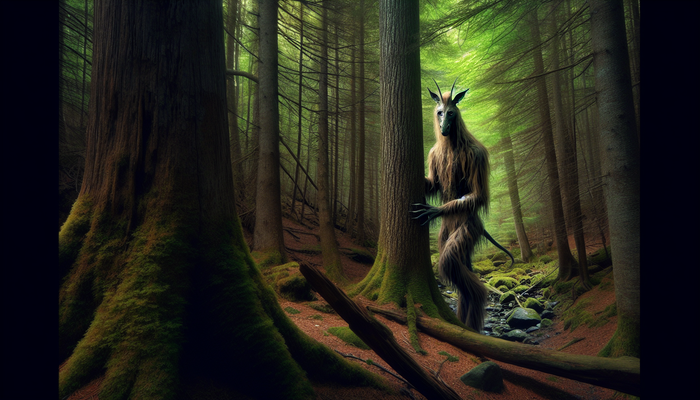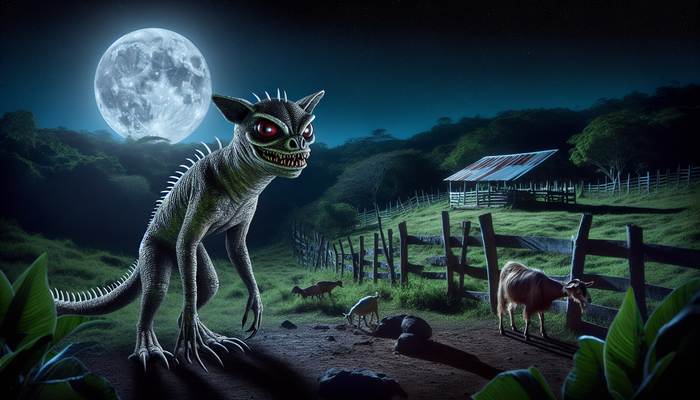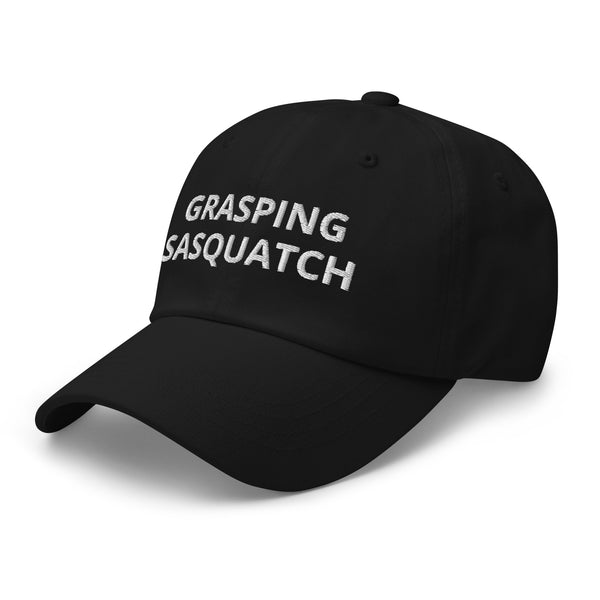Discover the Fascinating Lake Iliamna Monster Pictures and Legends
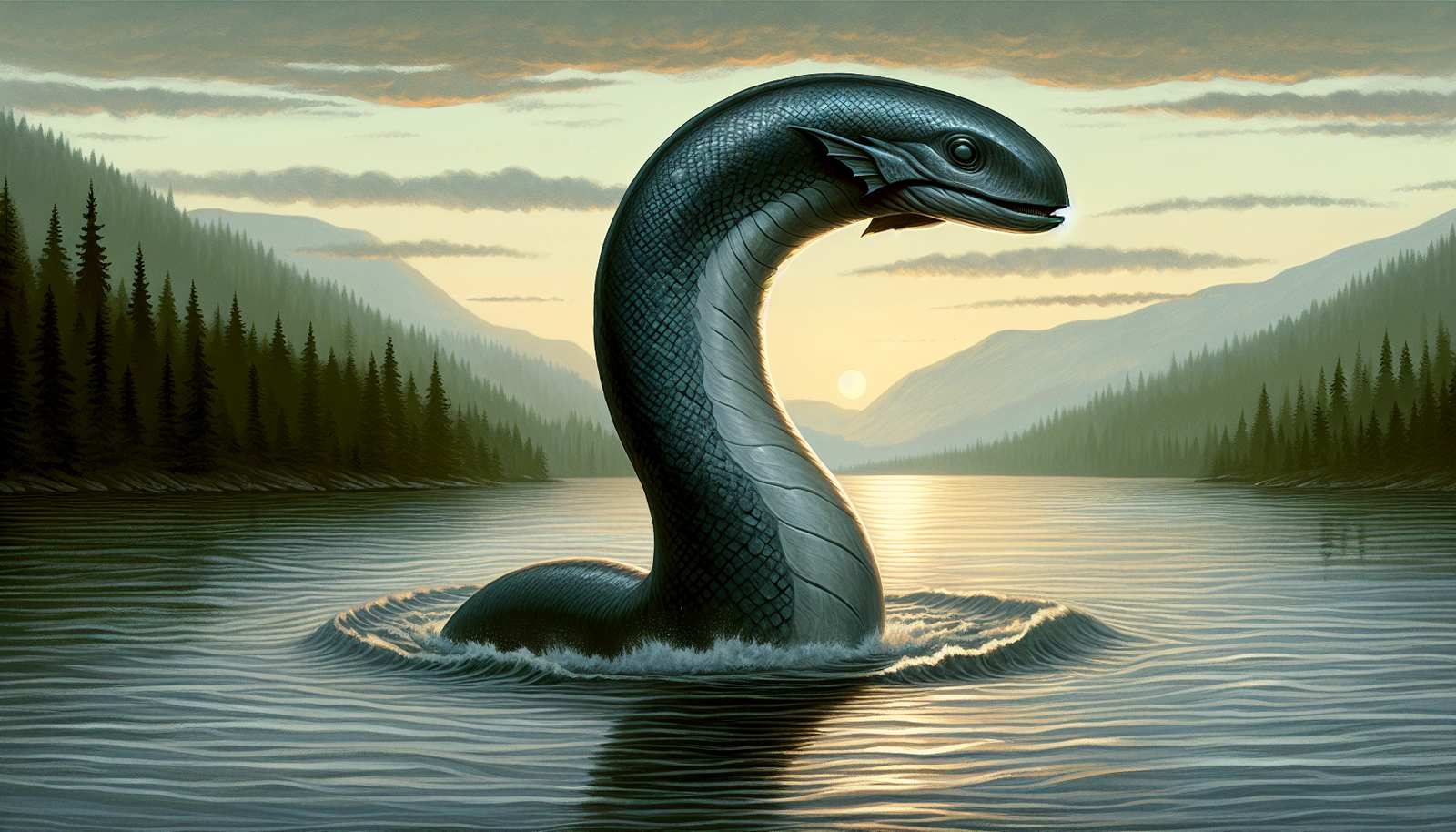
By James Roberts, Cryptozoologist
The Enigmatic Lake Iliamna
Picture, if you will, a body of water so vast it's often mistaken for an inland sea. Lake Iliamna stretches an impressive 77 miles long and 22 miles wide, with depths plunging to over 1,000 feet in places. This aquatic giant isn't just big; it's a complex ecosystem teeming with life, including the world's largest sockeye salmon run. Each year, millions of these fish surge into the lake, transforming its waters into a living tapestry of silver and red.
But it's not just the salmon that make Lake Iliamna special. The lake is home to a rare population of freshwater seals, a biological oddity that adds another layer of intrigue to its already mysterious waters. These seals, adapted to life far from the ocean, are a testament to the lake's unique character and its potential to harbor other unexpected inhabitants.
For the indigenous peoples who have called this region home for millennia, Lake Iliamna is more than just a geographical feature. It's a provider, a spiritual center, and a source of endless stories. The Tlingit and Aleut tribes have woven the lake into their cultural tapestry, respecting its bounty and fearing its depths in equal measure.
Origins of the Legend
Long before modern-day monster hunters set their sights on Lake Iliamna, the indigenous peoples of Alaska were sharing tales of a fearsome creature that called these waters home. The Tlingit spoke of "Gonakadet," a being with the head of a wolf and the body of an orca. This wasn't just any fish tale; Gonakadet was revered as a powerful spirit, capable of bringing both fortune and misfortune to those who encountered it.
The Aleut, on the other hand, told stories of the "Jig-ik-nak," a group of monstrous fish that struck fear into the hearts of warriors. These creatures were said to attack canoes, their massive forms capable of overwhelming even the bravest hunters. The Jig-ik-nak weren't just solitary predators; they hunted in packs, adding an extra layer of terror to their legend.
As European explorers and American settlers made their way to Alaska, these ancient stories began to blend with new sightings and experiences. The advent of aviation in the 1940s marked a turning point in the legend of the Lake Iliamna Monster. Suddenly, pilots were reporting strange sights from above – long, dark shapes moving beneath the surface, unlike anything they'd seen before.
One of the earliest and most famous modern sightings came in 1942 when bush pilot Babe Alsworth and his companion Bill Hammersley spotted something extraordinary during a flight over the lake. They described seeing several large, aluminum-colored creatures swimming just below the surface. These weren't small fish; Alsworth and Hammersley likened them to submarines, estimating their length to be greater than that of their plane's pontoon.
This sighting kicked off a new era in the legend of Illie. No longer was the creature just a part of indigenous folklore; it had entered the realm of modern mystery, sparking a wave of interest that would only grow in the decades to come.
Sightings and Eyewitness Accounts
The 1942 sighting by Alsworth and Hammersley was just the beginning. Over the years, a pattern of sightings emerged, each adding a new layer to the mystery of the Lake Iliamna Monster. In 1963, a biologist – whose name has been lost to time but whose account lives on – reported seeing a creature between 25 and 30 feet long. What made this sighting particularly intriguing was the duration; the biologist observed the animal for a full ten minutes, noting that it never surfaced for air.
Fast forward to 2017, and we have one of the most compelling mass sightings in the monster's history. Near the village of Kokhanok, multiple witnesses reported seeing not one, but three large creatures in the lake. Gary Nielsen, a local fisherman with years of experience on Iliamna's waters, described the largest as being "double the size of a 32-foot gillnetter." The creatures were said to surface like whales, spouting water, but with a crucial difference – the water came from the sides of their mouths, not from a blowhole.
What makes these accounts so compelling isn't just the details, but the credibility of the witnesses. These aren't wide-eyed tourists hoping for a glimpse of the extraordinary. They're experienced pilots, lifelong fishermen, and locals who know the lake like the back of their hand. When people like Gary Nielsen, who've spent their lives on these waters, say they've seen something unusual, it's hard not to take notice.
The descriptions of Illie have remained remarkably consistent over the years. Witnesses often describe a creature with a long, serpentine body, dark in color, with a length anywhere from 10 to 30 feet. Some reports mention a square-like head, used to ram small boats – a detail that adds a touch of aggression to the monster's reputation. The creature's color is frequently described as a dull aluminum, blending seamlessly with the lake's often-murky waters.
But it's not just the appearance that fascinates; it's the behavior. Many sightings involve multiple creatures, suggesting that Illie might not be a solitary beast but part of a larger population. Reports of the monsters herding seals or creating massive wakes have only added to the intrigue. Some witnesses have even claimed to see the creatures breach the surface, creating spectacular splashes before disappearing back into the depths.
These eyewitness accounts have had a profound impact on the legend of the Lake Iliamna Monster. They've transformed Illie from a vague mythical being into something more tangible, a creature that, while still unproven, feels just within the realm of possibility. The consistency of the reports, combined with the credibility of the witnesses, has kept the legend alive and fueled ongoing efforts to capture proof of Illie's existence.
The Search for Evidence
With so many compelling sightings, you might think that hard evidence of the Lake Iliamna Monster would be easy to come by. But Illie has proven to be as elusive as it is fascinating. Over the years, there have been numerous attempts to capture proof of the creature's existence, ranging from amateur expeditions to well-funded scientific endeavors.
One of the most famous efforts to prove Illie's existence came in 1980 when the Anchorage Daily News offered a whopping $100,000 reward for tangible evidence of the monster. This wasn't just a publicity stunt; it was a serious attempt to solve one of Alaska's most enduring mysteries. The reward sparked a flurry of activity around the lake, with hopeful monster hunters employing everything from traditional fishing methods to more creative approaches. One enterprising individual even tried to lure the creature to the surface by playing classical music over the water – a tactic that, while innovative, failed to produce results.
Despite the financial incentive and the increased attention, the reward went unclaimed. No one was able to produce a clear photograph, a video, or any physical evidence that could definitively prove the existence of the Lake Iliamna Monster. The failure to claim the reward didn't dampen enthusiasm for the hunt; if anything, it added to the creature's mystique.
In recent years, the search for Illie has taken on a more scientific bent. Marine biologist Bruce Wright has been at the forefront of these efforts, employing modern technology in the quest to uncover the truth. Wright and his team have used underwater cameras and sonar equipment to probe the lake's depths, hoping to capture footage of the elusive creature.
One of Wright's most intriguing experiments involved setting up a baited camera system in the lake. The idea was simple: attract the creature with food and capture it on film. While the experiment didn't produce clear evidence of Illie, it did yield some tantalizing results. In 2020, something large and unseen damaged the camera rig, tearing off part of the metal contraption that had been baited with salmon. Unfortunately, in a twist of fate that seems almost too perfect, the camera's battery had run out just before the incident occurred.
These technological efforts, while not yet successful in capturing definitive proof, have provided new insights into the lake's ecosystem. Sonar scans have revealed the presence of large, unidentified objects moving in the depths, fueling speculation about what might be lurking beneath the surface.
The challenges in capturing evidence of the Lake Iliamna Monster are numerous. The lake's vast size – it covers over 1,000 square miles – makes comprehensive searches difficult. The water's depth and often murky conditions further complicate matters, limiting visibility and making it easy for large creatures to remain hidden. Add to this the creature's reported ability to stay submerged for long periods, and you have a recipe for an extremely elusive subject.
Despite these challenges, the search continues. Each new sighting, each unexplained sonar blip, keeps the hope alive that one day, someone will capture the definitive proof needed to solve the mystery of the Lake Iliamna Monster once and for all.
Scientific Theories and Explanations
While the idea of a prehistoric monster lurking in an Alaskan lake is undeniably thrilling, scientists have proposed several more mundane – but no less fascinating – explanations for the Lake Iliamna Monster sightings. These theories attempt to reconcile the consistent eyewitness accounts with known species and biological possibilities.
The White Sturgeon Theory
One of the most popular scientific explanations for Illie is that the sightings are actually of white sturgeon. These prehistoric-looking fish can grow to impressive sizes, with some individuals reaching lengths of over 20 feet. Their appearance, with a long, streamlined body and bony plates along their back, could easily be mistaken for something more monstrous when glimpsed briefly or from a distance.
The white sturgeon theory has several points in its favor. These fish are known to inhabit waters in the Pacific Northwest, and their size and appearance match many of the descriptions of the Lake Iliamna Monster. Additionally, sturgeon are bottom-dwellers, which could explain why sightings are relatively rare – they might only be seen when they venture near the surface to feed.
However, there's a catch: while white sturgeon are found in other parts of Alaska, there's currently no evidence that they inhabit Lake Iliamna. This lack of confirmed presence has led some researchers to speculate that if sturgeon are responsible for the Illie sightings, they might represent a previously unknown population that has adapted to the lake's unique environment.
The Sleeper Shark Hypothesis
Another intriguing theory, proposed by Bruce Wright, suggests that the Lake Iliamna Monster might actually be a population of sleeper sharks that have adapted to freshwater. Sleeper sharks, which include the Greenland shark – known to live for centuries – are typically marine creatures. However, Wright believes it's possible that some may have become trapped in the lake as glaciers receded thousands of years ago, evolving to survive in freshwater.
The sleeper shark theory is compelling for several reasons. These sharks can grow to sizes that match the reported dimensions of Illie, and their slow-moving nature fits with many of the sightings. Additionally, sleeper sharks are known to be able to survive in very cold waters and can go long periods without feeding – characteristics that would be advantageous in a large, sometimes frozen lake like Iliamna.
Alternative Explanations
Of course, not everyone is convinced by these explanations. Skeptics point out that both the sturgeon and shark theories require significant leaps in our understanding of these species' abilities to adapt to new environments. They argue that misidentification of known animals is a more likely explanation for the Illie sightings.
- Freshwater Seals: One possibility is that witnesses are actually seeing the lake's population of freshwater seals. When seen in groups, these seals could potentially create the illusion of a larger, serpentine creature.
- Schools of Fish: Others suggest that large schools of fish, such as salmon during their annual runs, might be responsible for some of the sightings. When viewed from above, especially from a moving plane, a school of fish can create the impression of a single, massive creature moving through the water.
- Human Perception: The role of human perception and the power of suggestion can't be discounted either. In an environment as vast and sometimes forbidding as Lake Iliamna, it's easy for the mind to interpret ambiguous sights in light of known legends.
Despite these more prosaic explanations, the mystery of the Lake Iliamna Monster persists. The sheer number of sightings, combined with the consistency of the descriptions and the credibility of many witnesses, suggests that something unusual is indeed happening in the lake. Whether it's an unknown species, a known animal behaving in unexpected ways, or some combination of natural phenomena and human perception, the Iliamna Lake Monster continues to elude definitive explanation.
Artistic Representations and Cultural Impact
While photographic evidence of the Lake Iliamna Monster remains elusive, the creature has taken on a vibrant life in the realm of art and popular culture. Artists, inspired by eyewitness accounts and the allure of the unknown, have created a wealth of visual interpretations of Illie. These artistic renderings serve not just as entertainment, but as a way to bring the legend to life and make it accessible to a wider audience.
Many of these artistic depictions share common elements, reflecting the consistency in eyewitness descriptions. Illie is often portrayed as a sleek, serpentine creature with a long neck and a relatively small head. The creature's reported dull aluminum color is frequently represented, giving the monster an otherworldly, almost metallic sheen. Some artists choose to emphasize Illie's reported aggressive nature, depicting it with sharp teeth or in the act of attacking boats.
These visual representations have found homes in local galleries, on postcards, and increasingly, across social media platforms. Sites like DeviantArt and Instagram have become hubs for Illie artwork, with artists from around the world offering their own interpretations of the legendary creature. This online presence has helped to spread the legend of the Lake Iliamna Monster far beyond the shores of Alaska, introducing the mystery to a global audience.
The impact of these artistic representations can't be overstated. They've helped to solidify the image of Illie in the public imagination, giving a face to the formless descriptions of eyewitnesses. In many ways, these artworks have become as much a part of the legend as the sightings themselves, influencing how people think about and visualize the monster.
Popular Culture and Media
Beyond the realm of visual art, the Lake Iliamna Monster has made its mark on popular culture in various ways:
- Documentaries and TV Shows: The creature has been featured in numerous documentaries and television shows, perhaps most notably in an episode of Animal Planet's "River Monsters."
- Books: Both fiction and non-fiction books have played a role in spreading the legend of Illie. From children's stories to serious scientific explorations, the Lake Iliamna Monster has proven to be a versatile subject.
- Tourism: The legend has had a tangible impact on the local economy, with monster-themed tours, merchandise, and experiences drawing visitors from around the world.
- Conservation: The possibility of an unknown large species has heightened interest in preserving Lake Iliamna's ecosystem, leading to increased awareness of the lake's importance as a habitat.
In many ways, the cultural impact of the Lake Iliamna Monster mirrors that of other famous cryptids like Scotland's Loch Ness Monster or the Pacific Northwest's Bigfoot. These legends capture our imagination, challenge our understanding of the natural world, and remind us of the power of mystery. They become part of the identity of a place, woven into its cultural fabric in ways that transcend mere folklore.
The Ongoing Mystery
As we've explored the legend of the Lake Iliamna Monster, from its roots in indigenous folklore to its modern-day scientific investigations, one thing becomes clear: this is a mystery that continues to captivate and confound in equal measure. The enduring fascination with Illie speaks to something fundamental in human nature – our desire to believe that there are still wonders in the world waiting to be discovered.
The Lake Iliamna Monster has become more than just a potential cryptid; it's a symbol of Alaska itself. In a state known for its vast wilderness and untamed landscapes, Illie represents the idea that nature still holds secrets, that there are still frontiers to be explored. This symbolism resonates not just with Alaskans, but with people around the world who are drawn to the idea of the unknown.
Looking to the future, it's clear that the search for the Lake Iliamna Monster is far from over. Advances in technology offer new possibilities for exploration and documentation. Underwater drones, more sophisticated sonar equipment, and environmental DNA testing are just a few of the tools that could be brought to bear in future investigations.
As research continues, new theories and explanations are likely to emerge. Perhaps future studies will conclusively identify a known species as the source of the Illie sightings, or maybe they'll uncover evidence of something truly unexpected. The possibility of surprise is what keeps the mystery alive and continues to draw researchers and enthusiasts to the shores of Lake Iliamna.
One thing is certain: as long as there are unexplained sightings and unanswered questions, the legend of the Lake Iliamna Monster will continue to thrive. It will continue to inspire artists, challenge scientists, and capture the imagination of people around the world. In an age where it can sometimes feel like every corner of the globe has been explored and explained, Illie reminds us that there's still room for mystery and wonder in our world.
The story of the Lake Iliamna Monster is more than just a tale of an elusive creature. It's a narrative about human curiosity, the power of folklore, and the enduring allure of the unknown. Whether Illie turns out to be a misidentified known species, an as-yet-undiscovered animal, or simply a product of human imagination, its impact on the cultural landscape of Alaska is undeniable.
As we conclude our exploration of this fascinating legend, it's worth remembering that the true value of the Lake Iliamna Monster might not lie in its physical existence, but in its ability to inspire wonder, spark curiosity, and remind us of the vast, untamed wilderness that still exists in our world. In the end, perhaps it's not the answer to the mystery that matters most, but the questions it continues to provoke and the journeys of discovery it inspires.
For those intrigued by the legend of the Lake Iliamna Monster, the story is far from over. The lake itself remains a testament to the raw beauty of Alaska, inviting exploration and offering the promise of adventure. Whether you're a skeptic or a believer, a scientist or a storyteller, Lake Iliamna and its legendary inhabitant offer a reminder that in some corners of our world, mystery still thrives – and with it, the thrill of possibility.
From Bigfoot to UFOs: Hangar 1 Publishing Has You Covered!
Explore Untold Stories: Venture into the world of UFOs, cryptids, Bigfoot, and beyond. Every story is a journey into the extraordinary.
Immersive Book Technology: Experience real videos, sights, and sounds within our books. Its not just reading; its an adventure.


